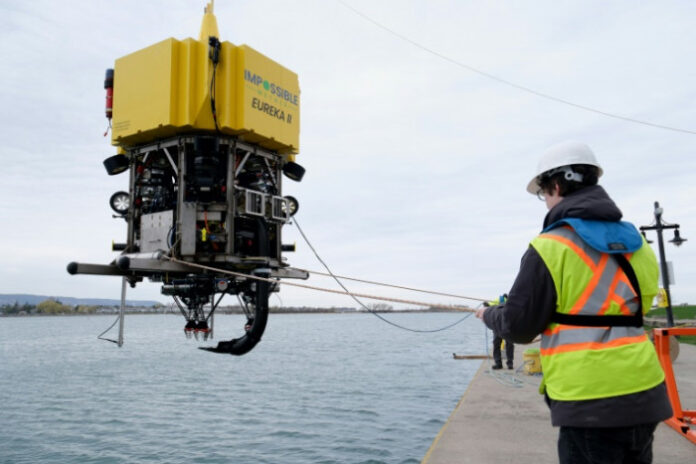In a Canadian lake in Collingwood, three robotic arms were extended to pick up pebbles. They then stored them inside the machine.
This exercise was part a series tests the robot underwent before its deployment in the ocean where its operators hope that the machine can transform search for the most sought after metals. The robot was created by Impossible Metals. This company, founded in California in 2020 claims to be working to develop technology to allow the seabed to harvest with minimal ecological disruption.
Underwater harvesting is a traditional method that involves scooping up large amounts of material to search for potato-sized poly-metallic nudules. These nodules are rich in nickel, copper, and cobalt. They can also be used to make electric vehicle batteries. Jason Gillham, Impossible Metals co-founder, told AFP that the robot of his company searches for nodules. “in a selective way.”
A prototype being tested in Ontario remains stationary in water and hovers over the bottom of the lake. In a laboratory, staff use a console that looks like a videogame console to control the robot’s movements.
The robot uses artificial intelligence and lights to identify nodules, while leaving aquatic life, such as coral or sponges, undisturbed.
– ‘A little like bulldozers.’
Impossible Metals, a pioneer in this new sector, has asked US President Donald Trump for a permit to use its robot around Samoa in the Pacific.
Impossible Metals hopes that its promise of minimal ecological disruption will make it more appealing. The Metals Company and other competitors use giant machines to roll along the seabed, sucking up the nodules. This is a controversial technique. Douglas McCauley is a marine scientist at the University of California Santa Barbara. He told AFP that this method uses collectors or excavators to scoop up ocean floor.
The nodules and waste are separated on ships before being thrown back into the ocean. He said that this creates large plumes containing toxins and sediment with a variety of potential impacts. McCauley explained that a less invasive method, such as the one advocated by Impossible Metals would reduce the risk for environmental damage. McCauley noted that harvesting with a lighter touch is not without risks. He said that the nodules also contain living organisms and that removing them, even with a select technique, would destroy their habitat.
Impossible Metals admits that its technology cannot detect microscopic organisms, but the company insists on leaving 60 percent of nodules intact. McCauley, however, is not convinced.
Duncan Currie from the Deep Sea Conservation Coalition stated that it was impossible to evaluate the impact of any deep-sea harvesting. He told AFP. According to the Ocean Census initiative, only 250,000 of the estimated two million species that populate the oceans are known.
High demand –
According to Impossible Metals’ chief executive and cofounder Oliver Gunasekara who has spent the majority of his career working in semiconductors, mining is “always going to have some impact,” . He added that “we need a lot more critical minerals, as we want to electrify everything.”
Illustrating a global rush towards underwater mining, Impossible Metals raised US$15,000,000 from investors in order to build and test the first series of its Eureka 3 robotic system in 2026.
A commercial version of the robot will be the size and shape of a shipping box, with up to 16 arms and a battery that will increase from 14 to 200 kilowatt hours. The robot will be self-propelled, fully autonomous, and equipped with sensors. It will not require cables or tethers.
The company hopes to finalize their technology within two to four years while awaiting the US greenlight. They will also conduct ocean tests, create a fleet and operate through partnerships around the world.





